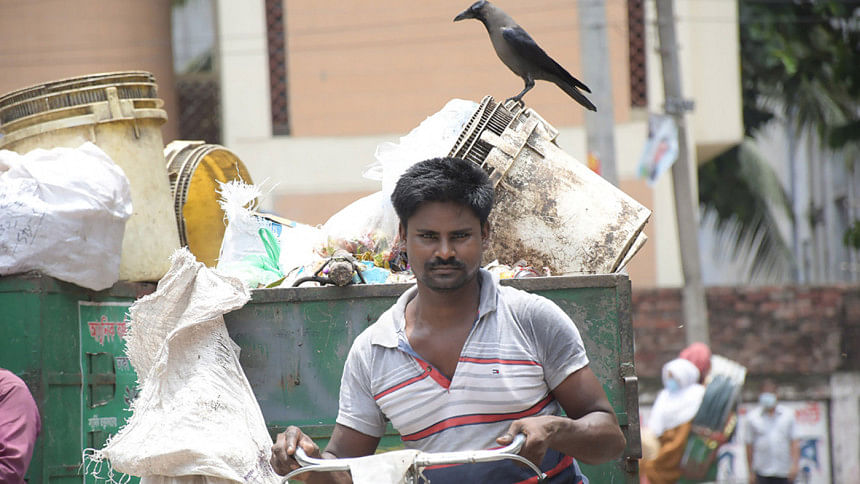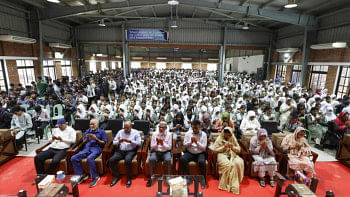The shunned, invisible cleaners of our city

As a child, my weekday dawns consisted of walking five or so minutes to the spot from where my school bus would pick me up. Most days were humid, some pouring, and very few freezing. But during practically every wait at the bus stop, I would see a handful of women and men in sleeveless, buttonless coats made of the cheapest cotton (passing as "protective gear"), sweeping dust and human-made garbage off the already busy main road and gathering those in clattering push-carts. Their collection would shortly be taken to the huge garbage bin nearby where the entire area's waste would go, too. Unsurprisingly, when I would sometimes have to walk past them or when they would be working close to me, my guardian would caution me to not accidentally brush up against the jharuwali and I would comply.
Besides street sweepers, Bangladesh has a wide array of subsections under the banner of "cleaner"—all of whom do jobs that no one would do willingly and tasks that pay a pittance. Their work mostly consists of garbage collecting and reselling and cleaning/unclogging drains and toilets. Sounds simple enough when put like that, but underneath the concise wording are thousands of stories of unjust, even cruel, working conditions. A series of articles published by The Daily Star (as part of its campaign with WaterAid Bangladesh and the Embassy of Sweden called "The Untold Stories of Sanitation and Waste Workers") on June 29 shed light on the lives of individual workers from this sector, detailing the horrible experiences they have had to face because of their occupations.
This is a sector characterised by the total lack of any regulations to protect workers and where the employment of children is a given. At the Matuail Sanitary Landfill, for instance, children as young as 10-years-old work alongside adults (often their parents, too) to collect plastic bottles, electronics, intact glass jars, etc.—anything that is reusable and can thus be sold to nearby scrap collection shops. Without any waste segregation system in our country, the children have to sort through mounds of all kinds of garbage (some as tall as five-storey buildings) for hours on end. In the process, they come into contact with toxic liquids, broken glass, blades, etc. while not wearing any kind of protective gear such as gloves or gumboots. Most of the time authorities/employers do not provide them with protective gear, and since nobody gives them a briefing on how dangerous their jobs are, it makes them quite indifferent about protective gear when on rare occasions, they are offered. But those who do want to wear protective gear have to resort to using flimsy polythene bags on their feet and hands to protect themselves to a small degree from the toxic waste.
However, some jobs in this sector are inherently dangerous—deadly, even—and even those have to be conducted by waste workers, unprotected and for measly pay. One of the stories from the aforementioned series details the situation of workers such as Riajuddin who have to enter water-logged manholes, sewage water coming up to their necks, to unclog pipes of polythene bags, pieces of glass, metal, wood, etc. bare-handed and with nothing to protect them from the dirty water or toxic gases inside the manholes. Aches, different kinds of pains, fever, and cuts are occupational hazards for workers like Riajuddin. 33-year-old sewer cleaner Rubel recalled the origin of the four-inch-long scar on his left leg. The cut appeared from a brick when he was cleaning a manhole, and "required 15 stitches and a week-long medical treatment" which cost Rubel and his family Tk 10,000. This amount had to be borrowed from friends and relatives (paid back over one year) instead of Rubel's employer taking responsibility. After a brief resolution to never go back to a profession which did not provide him safety or compensation, Rubel had to continue working again in order to provide for his family.
Calling such instances of injuries faced by sanitation and waste workers "occupational hazards" is not only an understatement, but also not factual. The Bangladeshi government issued a circular in 2013 listing 38 processes or activities which are deemed to be hazardous for children. Despite there being around 10,000 waste workers between the two city corporations of our capital, many of whom are minors, working with toxic waste (and sustaining illnesses and injuries on a daily basis) was not deemed to be one of these hazardous jobs. Moreover, working with waste also failed to make the cut in the 18-items-long list of hazardous operations under Section 83 of the Bangladesh Factories Rules 1979.
Besides physical ailments and injuries, even amongst those who belong to the same social strata as themselves, sanitation and waste workers are often shunned based on their profession. From tea stalls to local hospitals, these workers are, at best, told to keep a distance from the rest of the patrons/patients, if they are not refused service point-blank and/or shooed away. It goes without saying how people belonging to lower-middle to upper classes feel about those who work in this sector, but referring back to the very first paragraph might give you an inkling. If not for the thankless job that sanitation and waste workers do, our streets would be overflowing with all kinds of garbage within a day.
The sheer absence of rules and regulations to protect sanitation and waste workers gives employers the chance to get away with exposing workers to toxic waste, potential (and severe) injuries, and even death. On top of this, they are also not provided any form of insurance/risk allowance nor regular access to health services. The DNCC chief waste management officer said in a report to this newspaper that "they had provided masks, gumboots, gloves, aprons, raincoats, soaps and sanitiser to the workers," but because they "cannot work comfortably wearing these [...] [the workers] do not want to wear them". The DSCC's chief waste management officer meanwhile admitted that, though sick workers are provided with financial help from the mayor's fund, there is no insurance in place and that is something that both city corporations are working on.
While the possibility of sanitation and waste workers finally having some security in the form of insurance acts as a thin ray of hope, there needs to be major reform in this industry if the goal is to protect workers. For one, the elimination of children as waste workers needs to be prioritised. If this work is so dangerous for adults that they develop long-term health problems as serious as cancer, one can only imagine how drastic the effects must be on child labourers, especially if they are allowed to stay stuck in employment in this sector. Besides this, not only do workers need to be trained properly and equipped with protective gear, there must be no alternative to these. That is, a worker should not be allowed to be in a landfill or manhole unless they have been trained to ensure their safety and are wearing protective gear provided by the employer. Lastly, it is high time for Bangladesh to start segregating its garbage into organic waste, glass, metals, plastic, etc. For a country that seems to be progressing digitally and is set to graduate from its least-developed country status by 2026, it is woeful how criminally overlooked those who keep our environment clean and liveable are—at the cost of their own health and lives, and in exchange for pay they can barely live on.
Afia Jahin is a member of the editorial team at The Daily Star.

 For all latest news, follow The Daily Star's Google News channel.
For all latest news, follow The Daily Star's Google News channel. 



Comments